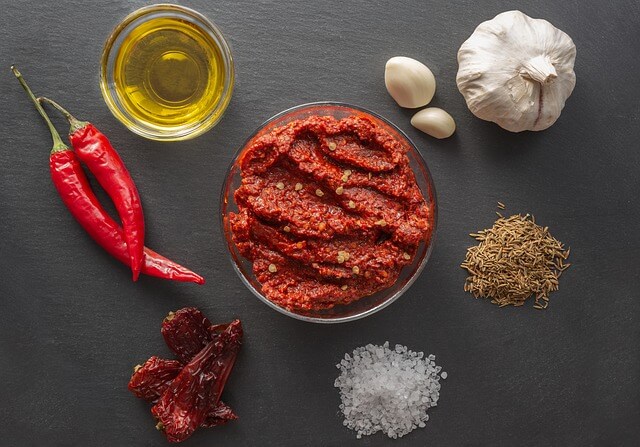In recent years, jars of sambal oelek have started to appear on grocery store shelves along with sriracha sauce. In this post we take a look at just what sambal oelek is and if you have never used it before, how you can use it to add some fire to everyday cooking.
If you do not have any sambal oelek sauce to hand, or are struggling to buy it easily, we also offer some substitutes that you can use – including an easy recipe to make samba oelek yourself from scratch.About Sambal Oelek
A sambal is a chili-based and spicy sauce used in many Southeast Asian countries, but particularly Indonesia and Malaysia. There are many different types of sambal sauce available, using different peppers, with different textures and made in different regions.
As Indonesia contains over 17,000 islands and most sambals are homemade, it is impossible to gauge how many variants there are of sambal at any given time.
The name sambal actually translates to ‘condiment’ and is also used to identify any dish that includes sambal as the main ingredient, so a sambal goreng udang is a shrimp dish seasoned with sambal sauce.
One key sambal sauce is sambal oelek (pronounced as zam-bahl U-lek). A native Indonesian sauce, but also popular in Thailand, Malaysia and Sri Lanka, sambal oelek or ulek is actually a paste, although often called a sauce, made from ground or pureed red chilies, vinegar and salt.
The word ‘oelek’ derives its name from the traditional Indonesian pestle and mortar or ‘ulek’ used to make the paste. Unlike other types of sambal, sambal oelek contains chili seeds and bits of pulp which give it a chunkier texture. Other variations of sambal oelek may contain additional ingredients such as sugar, garlic, citrus juice, spices or shallots.
It is not just the texture of sambal oelek that makes it different to the smoother sriracha sauce, but sambal oelek is also less processed that sriracha – giving it more of an unadulterated, hotter and less acidic chili flavor.
It is uncertain how long sambal oelek has been around for, as chili peppers only entered the Southeastern Asian regions with the Portuguese in the sixteenth century – not long after they were found growing in the Americas by the New World explorers. It is thought that the Asian cuisines quickly embraced the addition of chili to recipes and the use of chilies continued to develop into the key ingredient that they are in many of today’s Asian recipes.
Of all the sambals, sambal oelek is usually one of the easiest to buy, often found in larger grocery stores, as well as in ethnic or specialty stores. When using store bought or even homemade sambal oelek always give it a good stir before using as it can separate when stored. If you replace the lid tightly and store in the refrigerator after use, store bought sambal oelek will last almost indefinitely.Using Sambal Oelek In Recipes
Sambal oelek is best used as a condiment or hot sauce replacement for meats, curries, rice, soups, stews, stir fries, tofu and noodles and it can also be used as a way to add flavor to dips, sauces, marinades and even your eggs! If you want a spicy bite to a wrap or burger then sambal oelek can be mixed with mayo or ketchup.
If you want stronger flavor from sambal oelek then add it at the start of cooking, otherwise just add it at the end of cooking for some surface heat. If using sambal oelek for the first time, or one from a different producer, then always start by adding a very small amount – quarter of a teaspoon or so - until you have been able to assess its level of heat and flavor.

Sambal oelek was traditionally made as a way to preserve fresh chilies almost indefinitely, and so can also be used as a direct fresh or dried chili substitute in any savory dish. If a recipe needs a small jalapeno, then use a tablespoon of sambal oelek (or another type of sambal) to replace the jalapeno.
Sambal Oelek Substitutes
Depending where you live, it is now much easier to find sambal oelek, but if you are struggling to find some, or have just run out, here are a few things that you can use to substitute sambal oelek in a dish, including an easy recipe to make your own.
1. Homemade Sambal Oelek
If you have some hot red chilies at home, then making your own sambal oelek will give you the most similar flavor to a store-bought sauce. As this particular recipe requires you to cook the sambal oelek before use, you can also use frozen chilies.
Sambal oelek is best made with Thai chilies for a fiery sambal.
Thai chili peppers include around 80 different varieties of pepper with different levels of heat, but most are red, small sized and high in pungency and heat. Varieties of Thai chilies can also be known by other names such as Kashmir peppers, but as a rule, the two main types of pepper grown in Thailand are ‘bird peppers’ or prik khee nu or ‘chili pepper’ (prik khee fah).
These Thai peppers have a heat range of between 50,000 and 100,000 Scoville Heat Units making them around 15 times hotter than a typical jalapeno chili pepper. This is why you should always wear rubber gloves when handling Thai peppers and take care not to splash anything onto your face or eyes when preparing the chilies (or indeed any other hot chilies).

If Thai peppers are a little too fiery for you, then you can use Fresno chilies for a milder heat sambal. Red serrano chilies will give a sambal with around twice the heat of Fresno chilies, or you can also use red jalapeno peppers or cayenne peppers.
To make around ten servings of homemade sambal oelek, you will need the following:
- Half a pound of seeded and chopped red chilies – Remember to wear rubber gloves when preparing the chilies
- One tablespoon of vinegar
- One tablespoon of salt
- Half a teaspoon of salt
Add the chilies and water to your food processer and pulse chop into a coarse paste. Add this paste to a pan and place on medium heat for between three and five minutes. Stir frequently.
Finally, add the salt and vinegar to the pan and stir well. Allow the sauce to heat for another ten minutes while frequently stirring. Take the pan off the heat and allow the sambal oelek to cool. It can be used straightaway or refrigerated first for its best flavor. Store it in a suitable and airtight container in the refrigerator.2. Tabasco Sauce
Although a Cajun hot sauce, like sambal oelek, Tabasco is made with peppers, vinegar and salt, which makes it a suitable substitute for sambal oelek.
Tabasco was first created and produced in 1868 by Edmund McIlhenny on Avery Island in Louisiana. How Tabasco is made has changed very little since that time, and even today, all the seeds for the Tabasco peppers originate on Avery Island which are then sent to growers elsewhere, including Latin American countries.
Once Tabasco peppers are ready for harvesting, they are hand-picked in the same way that McIlhenny picked them and turned into a mash with salt. The barrels containing this mash are sealed, salted once more and then left to age for three years. The aged mash is then mixed with vinegar and stirred for a month, pulp and seeds separated, and the remaining sauce bottled.
Tabasco sauce should only be used in small amounts when being used as sambal oelek substitute as Tabasco does contain more vinegar. Just use half the amount of Tabasco than you would of sambal oelek to make sure you do not add too much acidity or sourness to the dish.

If you have other hot sauces such as Louisiana hot sauce in your pantry, these may also be suitable to replace sambal oelek – depending on of course what the recipe is.
3. Sriracha Sauce
In the US, sriracha sauce and sambal oelek are often made by the same producer. Although the texture of the two differs, there is still some similar flavors although the addition of garlic and less vinegar in sriracha sauce will make a slight difference to the overall flavor of the dish. You should only use sriracha if you are able to use a sauce rather than a paste in the recipe.
Try adding just half the amount of sriracha as you would of sambal oelek, you can then add more if needed.4. Chili Pastes
Other chili pastes like gochujang or harissa have the same consistency and often the same heat profile than sambal oelek, but these pastes can provide different flavors that can affect the overall taste of the dish.
The fiery taste of harissa complements stews, couscous, breads and more. Although its ingredients vary, harissa is made with chilies, vinegar, garlic and spices such as cumin, caraway, nutmeg, allspice or coriander. It can also contain herbs such as mint.

If you are considering using harissa, or any other type of chili paste in place of sambal oelek, then check the label carefully and choose one with minimal quantities of other spices in it.
The fermented and rich sweetness of gochujang can mean it is unsuitable to replace a simple sambal oelek in most recipes.5. Red Pepper Flakes or Cayenne Pepper
As long as the sambal oelek is not used in the recipe as a binder ingredient, then as a last resort, a quarter teaspoon of red pepper flakes or cayenne pepper in place of a teaspoon of sambal oelek will replace the heat in the dish, but not the flavor.

Final Words
If you are out of store bought sambal oelek, the easiest substitute is to make your own, as it needs so few ingredients and only a little time to prepare and cook. Otherwise, Tabasco or sriracha sauces are probably the next easiest substitutes but be cautious – only add around half the amount of one of these to the dish as you would add of sambal oelek.
If you want to add fire to your eggs, marinades, tofu or more but have run out of sambal oelek, or are struggling to find it in grocery stores, it is good to know that there are a number of substitutes available to replace the heat – if not all of the flavor – of sambal oelek in any type of dish.

